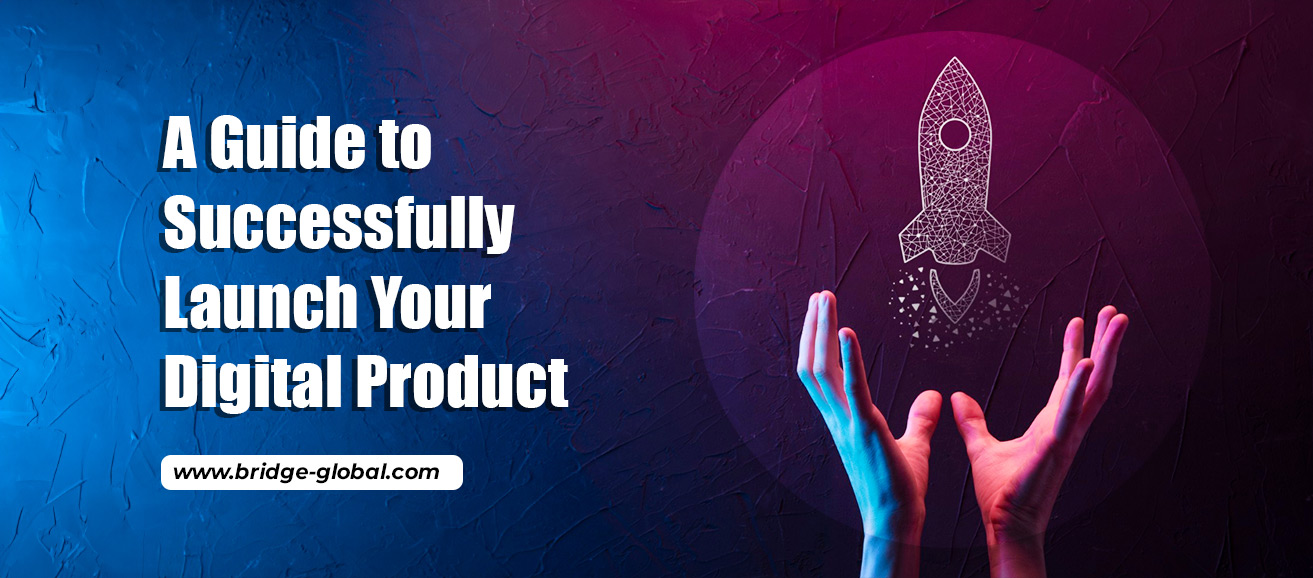Digital Product Development – A Complete Guide From Idea to Launch
Gone are the days when digital product development was viewed as a linear process of collecting requirements and passing them to IT or software engineers. The evolving landscape emphasizes collaborative and iterative approaches that involve cross-functional teams working together from ideation to delivery following an agile development process.
Digital product development extends beyond mere technical execution; it's a dynamic and interdisciplinary journey. For those seeking to forge a product from the ground up, this guide outlines essential steps for organizations and startups. We'll delve into the definition of digital products first and then move on to the key stages involved in the digital product development journey.
The global digital product development market is poised to stay strong as per reports by Statista. It says that “by 2026, global digital transformation spending is forecast to reach 3.4 trillion U.S. dollars.”
What Is Digital Product Development?
Digital product development refers to the end-to-end process of conceptualizing, designing, building, and iterating digital products. Digital products are intangible goods or services that exist in a digital format, typically accessible and deliverable through electronic means.
These products are created, distributed, and consumed electronically, often via the Internet or digital devices. Examples of digital products include e-books, software applications, online courses, digital music, stock photos, mobile apps, digital artwork, webinars, subscription services, video games, virtual products, etc.

Digital product development involves a comprehensive approach, incorporating elements like user experience design, software development, testing, and continuous improvement. The aim is to create products that effectively meet user needs, provide value, and align with business objectives. This dynamic and iterative process often involves cross-functional collaboration, agile methodologies, and a focus on user feedback to ensure that the final product is not only technically robust but also user-friendly and market-responsive.
11 Key Stages in Digital Product Development
Digital product development involves several key stages as below.
Stage 1: Ideation
This stage involves generating and refining innovative ideas for the digital product, considering market needs, user preferences, and business goals.
The ideation stage of digital product development marks the creative genesis, where innovative concepts are born. It involves exploring market trends, identifying user needs, and brainstorming ideas that have the potential to address specific challenges or enhance experiences. This phase encourages a diverse range of perspectives, fostering an environment where groundbreaking concepts emerge. Successful ideation lays the foundation for a digital product that not only meets market demands but also resonates with users, offering a unique and valuable solution.
Stage 2: Conceptualization
This stage involves the development of a high-level concept, outlining the core features, functionalities, and target audience of the digital product.

The visionary ideas generated during ideation take shape into a strategic plan. Here, a high-level concept is refined, outlining the core features, functionalities, and the intended target audience. It's a pivotal phase where feasibility is assessed, and the product's overarching goals are crystallized.
This stage serves as the blueprint, guiding subsequent development stages and ensuring alignment with the overarching vision. A well-defined concept acts as the compass, directing the digital product toward success by providing a clear path for further planning, design, and development efforts.
Stage 3: Planning
This stage involves the creation of a detailed project plan that includes timelines, resource allocation, and a roadmap for the development process.
This is the meticulous blueprinting phase, translating innovative ideas into a structured roadmap. Here, timelines, resources, and strategic milestones are carefully outlined, ensuring a clear path from concept to execution. This stage involves defining the scope of the project, allocating tasks, and establishing key deliverables. Thorough planning sets the foundation for a streamlined development process, enabling teams to navigate challenges effectively and stay on course. It serves as the crucial bridge between ideation and execution, ensuring that the digital product is not only innovative but also feasible within defined constraints.
Stage 4: Design & Prototyping
This stage involves the crafting of the user interface (UI) and user experience (UX) design to ensure an intuitive and visually appealing product. The team builds interactive prototypes to test and validate the design and functionality before full-scale development.
This is the stage that transforms conceptual ideas into tangible, interactive models. Here, designers and developers collaborate to create a visual representation of the product's user interface and functionality.
Prototypes (MVPs) serve as a dynamic testing ground, allowing teams to gather early feedback, identify design flaws, and refine user experiences before full-scale development.
This iterative process ensures that the final product aligns closely with user expectations and design objectives. The prototyping stage is a pivotal bridge between concept and creation, providing a valuable blueprint for the seamless development of a user-centric digital product.

Stage 5: Development
This stage involves writing code and developing the actual digital product, following the specifications outlined in the design and prototype stages. Each team member contributes distinctive expertise and perspectives to the project, guaranteeing that the final product aligns with essential quality deliverables.
Following the prototyping stage in the digital product development cycle, the focus shifts to full-scale development. During this crucial phase, the envisioned concepts and refined prototypes are translated into functional and interactive digital products. Developers begin writing the code, integrating features, and ensuring the product aligns with the design specifications. Continuous testing and refinement are paramount, addressing any issues identified during the prototyping stage. The development phase aims to bring the product to life, laying the technical foundation for its eventual launch and user interaction.
Make sure to hire certified and experienced software developers to ensure quality delivery.
Stage 6: Testing
This stage involves conducting thorough testing to identify and fix bugs, ensuring functionality, and optimizing the user experience.
The testing stage in digital product development is a critical phase where the product undergoes thorough examination to ensure functionality, identify and address bugs or issues, and validate the user experience. Software quality assurance professionals rigorously test the software against predetermined criteria, including performance, security, and usability. User acceptance testing may also take place during this stage, involving real users to provide feedback on the product's usability and overall satisfaction. The testing phase is instrumental in refining and enhancing the digital product, guaranteeing a high level of quality before its official release.
Stage 7: Launch
This stage involves the release of the digital product to the market, making it accessible to users.

The launch stage in digital product development marks the exciting moment when the product is introduced to the market, and becomes accessible to users. It signifies the conclusion of meticulous planning, creative ideation, and dedicated development efforts. With the product now live, users can experience and benefit from its features. Launching involves strategic marketing initiatives to create awareness and attract the target audience.
This stage is a pivotal transition from development to real-world application, and the team's focus shifts to user engagement, support, and gathering valuable insights for future enhancements.
Are you planning to launch a mobile application? Here is a comprehensive read on the process of mobile app development.
Stage 8: Marketing
This stage involves the implementation of marketing strategies to promote the product and attract users, including social media campaigns, advertising, and public relations.
The marketing stage in digital product development is a strategic effort to promote and generate awareness about the newly launched product. This phase involves a combination of targeted advertising, social media campaigns, content creation, and other promotional activities to reach the intended audience.
The goal is to highlight the product's unique value proposition, features, and benefits, encouraging user adoption. Digital Marketing efforts extend beyond the initial launch, with ongoing strategies to sustain interest, attract new users, and build a loyal customer base. A successful marketing stage is integral to maximizing the product's visibility and ensuring its long-term success in the competitive digital landscape. In a very practical sense, the marketing stage can ensue as soon as the concept is finalized.
Stage 9: Feedback and Iteration
This stage involves gathering user feedback and analytics data to understand how the product is performing. Use this information to make improvements and release updates.
The Feedback and Iteration stage in digital product development is a dynamic process of refinement and enhancement. Here, user feedback takes center stage, providing valuable insights to identify areas for improvement and optimization. Teams analyze user responses, address issues, and implement iterative updates to enhance functionality and user experience. This continuous loop ensures the product evolves in alignment with user needs, industry trends, and emerging technologies. The Feedback and Iteration stage is pivotal for maintaining a user-centric approach and fostering a product that consistently meets and exceeds expectations.
Stage 10: Scaling
This stage involves scaling the product to handle increased user demand, both in terms of infrastructure and features.
The scaling stage in digital product development is the strategic expansion to accommodate growing user demand and ensure optimal performance. This phase involves enhancing infrastructure, optimizing resources, and scaling features to handle increased usage seamlessly.
The goal is to maintain product stability, speed, and reliability as the user base expands. The scaling stage is a critical transition, marking the product's readiness to handle larger audiences and intensified usage scenarios. It's a strategic move to sustain and enhance the product's success in a dynamic digital landscape.

Wrapping Up
These stages form a cyclical process, with continuous feedback and iteration to adapt to market changes and user requirements. Successful digital product development requires a holistic approach, considering both technical and user-centric aspects throughout the lifecycle.
A stellar digital product has the power to set a business apart, expanding its user base, establishing credibility, and boosting revenue over time. With around two decades of experience, Bridge Global specializes in creating digital products that elevate operations and drive revenue growth for clients. If you're seeking support or want to explore a project, let's connect and make it happen.



